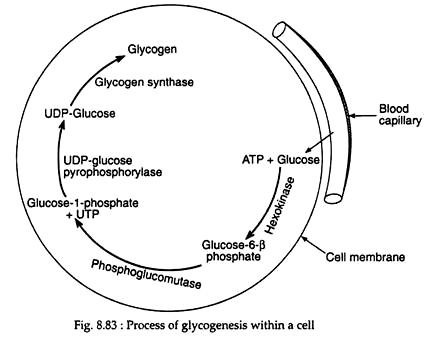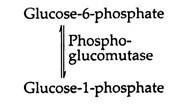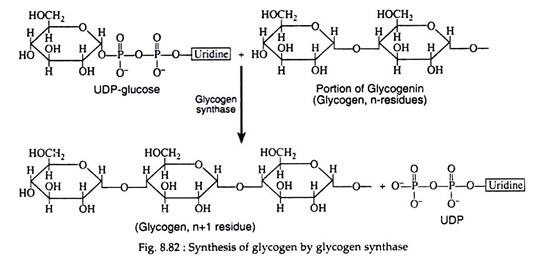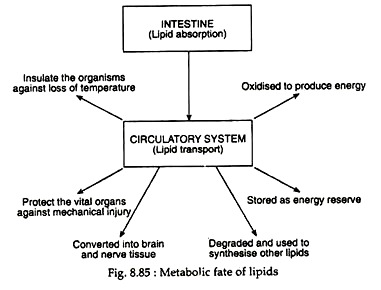In this article we will discuss about the process of glycogenesis.
The process of formation of glycogen from glucose in the tissues is called glycogenesis. Different tissues of the living organisms store carbohydrate as glycogen. The steps of glycogenesis are as follows (Fig. 8.83).
1. Glucose is phosphorylated to glycose-6- phosphate by the enzyme hexokinase (glucokinase) in presence of a phosphate donor, ATP.
ADVERTISEMENTS:
Glucose + ATP hexokinase→ Glycose-6-phosphate + ADP
2. Glycose-6-phosphate is transformed into glucose-1-phosphate, catalysed by the enzyme phosphoglucomutase.
3. Glucose-1-phosphate is converted to UDP-glucose by the enzyme UDP-glucose pyrophosphorylase in the presence of UTP (Fig. 8.81). The pyrophosphate (PPi) is immediately hydrolysed by inorganic pyrophosphatase, releasing energy. Thus the overall reaction is very exergonic and essentially irreversible.
4. Glycogen synthase (synthetase) transfers the glucosyl residue from UDP-glucose to the C4OH at the non-reducing end of a glycogen molecule, forming an α 1, 4 glycosidic bond. It is fact that glycogen synthase cannot unite to UDP-glucose, but it can only extend and existing chain (Fig. 8.82).
So, glycogen synthase needs a primer, which is a protein called glycogenic Glycogenin contains eight glucosyl units linked via a 1-4 linkages, which are added to the protein by itself (i.e., autocatalysis). Glycogen synthase can extend this molecule only.
Each glycogen synthase can extend this molecule only. Each glycogen granule contains only a single glycogenin molecule at its core. Glycogen synthase enzyme is becoming active when it comes in contact with glycogenin. On the other hand glycogenin limits the size of the glycogen granule.
ADVERTISEMENTS:
5. An enzyme, called branching enzyme [amylo-(1, 4′ → 1, 6′) transglycosylase] transfers a part of the 1, 4′-chain (about seven glucose unit) to a more interior site in the glycogen molecule and reattaching it by forming α1, 61 glucosidic bond with a branching point (Fig. 8.59).
Glycogen degradation (Catabolism):
Breaking of glycogen to form glucose is called glycogen degradation.
The process requires two enzymes; the action of them is as follows:
1. Glycogen phosphorylase (or phosphorylase) degrades glycogen by breaking α 1, 4′ glycosidic bond. This enzyme release glucose units one at a time from non-reducing end of the glycogen molecule and produce glucose-1-phosphate. For this reaction, inorganic phosphate (Pi) is also required.
This reaction is an example of phosphorolysis, i.e., breakage of a covalent bond by the addition of a phosphate group.
The limitation of glycogen phosphorylase enzyme is that, it can remove only those glucose residues that are more than five units apart from branch point.
2. Glycogen de-branching enzyme removes the α 1-6′ glycosidic bonds and allows glycogen phosphorylase to continue its function.
ADVERTISEMENTS:
3. Phosphoglucomutase converts glucose-1-phosphate to glucose-6-phosphate.
4. Glucose-6-phosphate is converted to glucose in liver by the enzyme glucose-6-phosphatase. This glucose then diffuses to circulation to maintain blood glucose concentration.
In muscle glucose-6-phosphate is metabolised immediately through glycolysis. It is to be noted that muscle does not contain glucose-6-phosphatase enzyme, so no question of glucose diffusion from muscle cells into blood stream.
Gluconeogenesis:
Synthesis of glucose from non-carbohydrate precursors, including lactate and pyruvate, citric acid cycle intermediates the carbon skeletons of most amino acids and glycerol, is called gluconeogenesis. The liver is the main site of gluconeogenesis.
The other organs with little capability of gluconeogenesis are kidney, brain and muscle. In liver cells, the first enzyme of gluconeogenesis, pyruvate carboxylase, is located in the mitochondrial matrix. The last enzyme, glucose-6-phosphatase is bound to the smooth endoplasmic reticulum. The other enzymes of the pathway are located in the cytosol.
Apparently gluconeogenesis appears to be a reversal of glycolysis. In glycolysis, glucose is metabolised to pyruvate and in gluconeogenesis pyruvate is metabolised into glucose. Indeed, some of the reactions of glycolysis are reversible and so the two pathways of these reactions have these steps in common.
But three steps in glycolysis are essentially irreversible; those catalysed by the enzymes hexokinase, phosphofructokinase (PFF) and pyruvate kinase. All these reactions are ATP mediated and drives glycolysis forward towards pyruvate formation. In gluconeogenesis these three steps are reversed by using other reactions (Fig. 8.85). Therefore, gluconeogenesis is not a simple reversal of glycolysis.
Precursors for gluconeogenesis:
1. Glycerol enters into the gluconeogenesis pathway through dihydroxy acetone phosphate.
2. Lactate, pyruvate, citric acid cycle intermediates and the carbon skeleton of amino acids are at first converted into oxaloacetate.
Steps of gluconeogenesis:
1. The enzyme pyruvate carboxylase converts pyruvate to oxalacetate by carboxylation (Fig. 8.85). This enzyme is located in mitochondrial matrix and uses biotin as an activated carrier of CO2, the reaction occur in two stages:
E-biotin + ATP + HCO3– → E-biotin-CO2 + ADP + Pi
E-biotin – CO2 + Pyruvate → E-biotin + Oxaloacetate
2. Phosphoenolpyruvate carboxykinase (PEPCK) enzyme simultaneously decarboxylates and phosphorylates oxalacetate to form phosphoenol puruvate (PEP), releasing CO2 and using GTP.
Therefore, it is apparent that reversal of pyruvate to PEP needs the input of a substantial amount of energy, one ATP for the pyruvate carboxylase step and one GTP for the PEPCK step.
3. PEP is then converted to fructose-1, 6- bisphosphate in a series of steps that are a direct reversal of those in glycolysis described earlier. This sequence of reactions uses one ATP and one NADH for each PEP molecule metabolised.
4. Fructose 1, 6-bisphosphate is dephosphorylated to form fructose 6-phosphate by the enzyme fructose 1, 6-bisphosphatase.
Fructose 1, 6-bisphosphate + H2O → Fructose 6-phosphate + Pi
5. Fructose 6-phosphate is converted to glucose-6-phosphate by the glycolytic enzyme phosphoglucoisomerase.
6. Glucose 6-phosphate is converted to glucose by the enzyme glucose 6-phosphatase, present in SER.
Glucose 6-phosphate + H2O → Glucose + Pi
Energetics:
Energy is required to synthesise glucose by gluconeogenesis. Two 3 carbon pyruvate molecules are required to synthesise one hexose glucose.
Hence, energy required in different steps is as follows:






